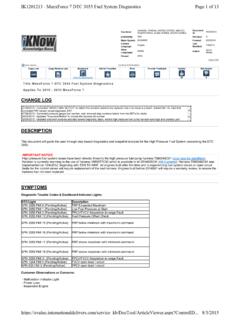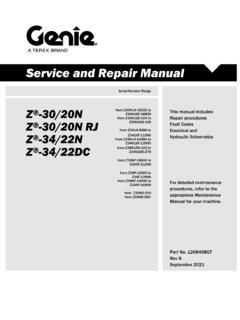Transcription of Online library of Quality, Service Improvement and ...
1 Online library of Quality, Service Improvement and Redesign tools Driver diagrams NHS England and NHS Improvement Driver diagrams What is it? A driver diagram is a tool that can be used to help plan Improvement project activities. Driver diagrams are essentially another name for the classic tree diagrams ' commonly used in operational research. When to use it When you are dealing with complex change it is often difficult to differentiate between cause and effect and it is rare to be able to attribute a particular outcome to one particular change you have made. Driver diagrams can be used to show your theories of cause and effect in your system in other words, your theories about what changes will likely cause the desired effects and achievement of your aim. It is helpful to create driver diagrams during the initial planning stages of your change programme, but they should also be used throughout your change programme.
2 Regular review of your driver diagrams will allow you to update them as you refine your theory of change in your system and learn more about the cause and effect relationships that are in play. How to use it Driver diagrams are structured charts of three or more levels. They translate a high level Improvement goal/aim into a logical set of high level factors (primary drivers) that you need to influence in order to achieve your goal. They also show the specific projects/activities that would act on these high level factors. Quality, Service Improvement and Redesign Tools: Driver diagrams Figure 1: Driver diagram showing goal/aim, drivers and projects/activities GOAL/AIM DRIVERS PROJECTS/ACTIVITIES. Ask yourself: Ask yourself: Ask yourself: What is the big What are the problems What projects/activities problem you are that cause bigger can you undertake that addressing?
3 Problems? will result in the What are you trying to What are you trying to Improvement you seek? achieve (aim)? achieve (aim for each What are the changes driver)? you want to test before implementing? Which in turn contribute Contribute directly to the directly to the bigger aim drivers PROJECT 1. PRIMARY DRIVER. PROJECT 1. THE GOAL PRIMARY DRIVER PROJECT 1. PROJECT 1. PRIMARY DRIVER. PROJECT 1. Quality, Service Improvement and Redesign Tools: Driver diagrams Driver diagram levels Basic driver diagrams show three levels (goal, primary drivers and projects/actions). Driver diagrams relating to more complex goals expand the number of levels so that each primary driver has it own set of underpinning factors. In the example below, the driver diagram relates to the overall aim of reducing driving fuel costs. Figure 2: Driving diagram reducing driving fuel costs PRIMARY SECONDARY TERTIARY PROJECTS OR.
4 AIM. DRIVERS DRIVERS DRIVERS ACTIVITIES. Reduce fuel Shop at a cheaper price per gallon petrol station Walk to work instead Reduce miles driven of driving Decrease fuel costs Buy a more fuel Increase car efficiency efficient car Increase efficiency Decrease use of rapid (mpg). breaking Improve driving Improve driving pattern habits Increase use of appropriate gears The driver diagram starts with a clearly defined and measurable goal. This is the focal point for your change efforts. The overall goal is linked in this example to three factors/sub-goals that are believed to have a direct impact on it (ie fuel costs will reduce if you find cheaper fuel , reduce the number of miles your drive or increase your fuel efficiency). The first set of underpinning goals are referred to as primary drivers because they drive'. the achievement of your main goal.
5 These drivers may act independently or in combination to achieve the overall goal/aim. Quality, Service Improvement and Redesign Tools: Driver diagrams The process of breaking down a goal can continue to lower levels to create secondary or tertiary drivers (and even further if required). In this example, the primary driver has been broken down to show some secondary drivers (ie you can increase efficiency by increasing car efficiency and improving your driving pattern). The improve driving patterns' secondary driver is then broken down to show some tertiary drivers. The ultimate aim of a driver diagram is to define the range of projects (ie actual change initiatives) that you want to undertake. These can appear anywhere in the hierarchy of the driver diagram wherever makes most sense. In the example above, you can see that some projects are linked directly with primary drivers, some with secondary drivers and others with tertiary drivers.
6 Creating your driver diagram There is no single correct way of drawing a driver diagram and there is no prescribed number of primary and secondary drivers or actions that should be included. What is important, however, is that the diagram clearly shows the causal relationships between the projects, hierarchy of drivers and aim. To create your driver diagram, you should: 1. Gather together the relevant stakeholders who have knowledge and different perspectives of the system you are working in 2. Start with your aim/goal make sure it is clearly defined and measurable. Think about: a. What? b. How much? c. By when? d. Why? So what? 3. Brainstorm potential drivers To achieve our goal, the things we need to improve Concentrate on generating ideas at this stage, don't try to allocate the label of primary or secondary driver at this stage 4.
7 Once you've completed the brainstorming, cluster the ideas to see if there are groups that represent a common driver. Make sure you use language like improve' or decrease' and that each driver is clearly defined (and is potentially measurable). 5. At this stage, you may want to expand the groups as new ideas may come to mind during the clustering stage 6. Now you can identify the links between the drivers and create the driver diagram format 7. Add projects/actions for the drivers 8. Finally decide which drivers and projects/actions you want to prioritise and which you want to measure. Quality, Service Improvement and Redesign Tools: Driver diagrams Figure 3: A driver diagram template AIM PRIMARY DRIVERS SECONDARY DRIVERS CHANGE IDEAS. Quality, Service Improvement and Redesign Tools: Driver diagrams What next? Create your driver diagram with your change project's stakeholders.
8 This provides an opportunity to check your plans in terms of equity making sure you are thinking about and engaging others affected. Your driver diagram represents your change strategy at that point in time. It shows that strategy on a single page in a simple, visual way. It helps to ensure that everyone understands the goal and how they can contribute to achieving it as well as helping you to co-ordinate those efforts. The simple tree-like structure also means that people can readily identify where they might have a different perspective. Use the driver diagram to maintain an overview of the big picture and to stimulate discussion about what is and is not significant. You may also want to think about prioritising the drivers by selecting some quick wins or by dismissing other drivers that have relatively little impact. Some drivers might be outside the span of control of an individual organisation but you might be able to influence them through working in partnership.
9 Driver diagrams evolve over the lifetime of an Improvement programme as you develop insight into different factors that contribute to the goal or vision and as new stakeholders emerge. It is therefore a live' document and so to get the most benefit from it, you should review and repeat it every 90 days or so. Additional resources Raleigh, VS and Foot, C (2010) Getting the Measure of Quality: Opportunities and Challenges, London: King's Fund Quality, Service Improvement and Redesign Tools: Driver diagrams

















